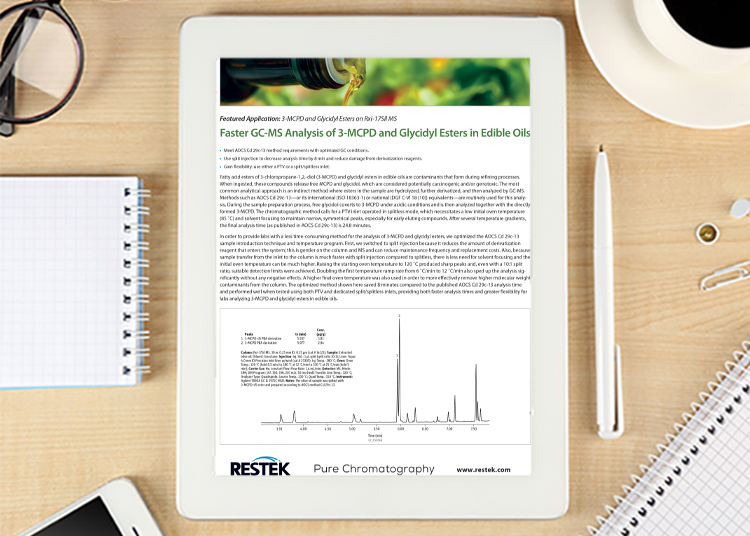Application note: Faster GC-MS Analysis of 3-MCPD and Glycidyl Esters in Edible Oils
- Like
- Digg
- Del
- Tumblr
- VKontakte
- Buffer
- Love This
- Odnoklassniki
- Meneame
- Blogger
- Amazon
- Yahoo Mail
- Gmail
- AOL
- Newsvine
- HackerNews
- Evernote
- MySpace
- Mail.ru
- Viadeo
- Line
- Comments
- Yummly
- SMS
- Viber
- Telegram
- Subscribe
- Skype
- Facebook Messenger
- Kakao
- LiveJournal
- Yammer
- Edgar
- Fintel
- Mix
- Instapaper
- Copy Link
Posted: 18 March 2020 | Restek | No comments yet
Fatty acid esters of 3-chloropropane-1,2,-diol (3-MCPD) and glycidyl esters in edible oils are contaminants that form during refining processes. When ingested, these compounds release free MCPD and glycidol, which are considered potentially carcinogenic and/or genotoxic. The most common analytical approach is an indirect method where esters in the sample are hydrolysed, further derivatised, and then analysed by GC-MS. Methods such as AOCS Cd 29c-13—or its international (ISO 18363-1) or national (DGF C-VI 18 (10)) equivalents—are routinely used for this analysis. During the sample preparation process, free glycidol coverts to 3-MCPD under acidic conditions and is then analysed together with the directly formed 3-MCPD. The chromatographic method calls for a PTV inlet operated in splitless mode, which necessitates a low initial oven temperature (85 ˚C) and solvent focusing to maintain narrow, symmetrical peaks, especially for early eluting compounds. After several temperature gradients, the final analysis time (as published in AOCS Cd 29c-13) is 24.8 minutes.
Related content from this organisation
- Keep abreast of the latest food safety updates
- Food Safety In-Depth Focus – October 2020
- Application note: Robust analysis of fatty acids in milk
- Application note: Improve acrylamide analysis in food with a long-lasting LC column and a cost-effective internal standard
- Application note: Pyrrolizidine Alkaloids on Raptor ARC-18










